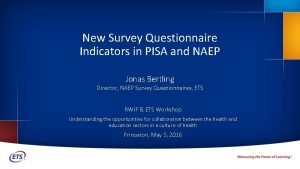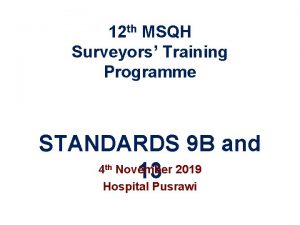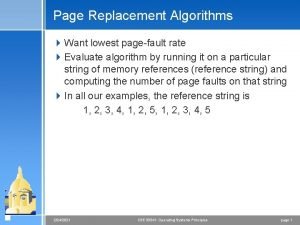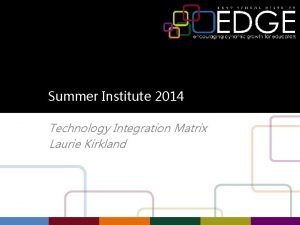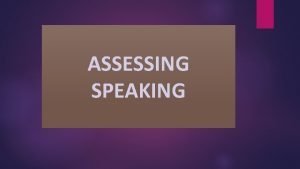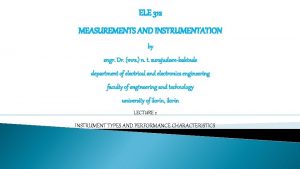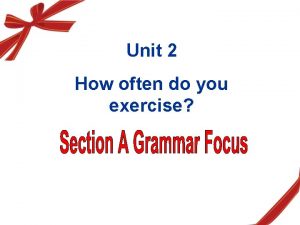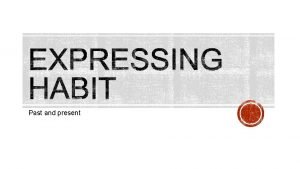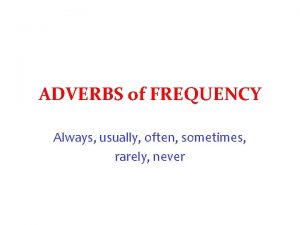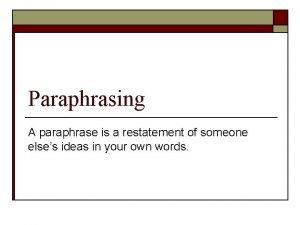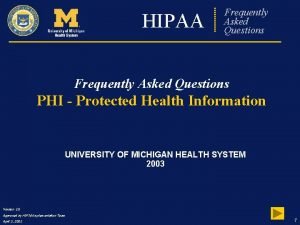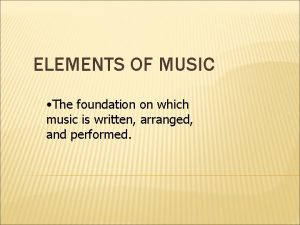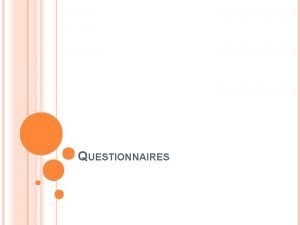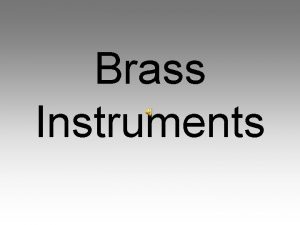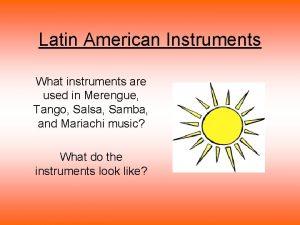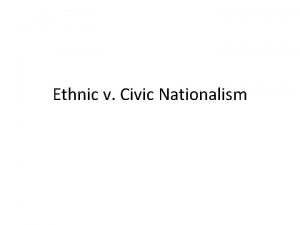Questionnaires as Instruments Questionnaires Most frequently used survey






















- Slides: 22

Questionnaires as Instruments • Questionnaires – Most frequently used survey instrument – Are scientific instrument just like an MRI machine – Quality of the questionnaire determines accuracy and precision of the measurements – Preferences and attitudes • most often these are measured with self-report scales • participants respond on rating scales – Usually Likert scales from 1 -7 or 1 -9 – For example, an assessment of emotional well-being might include the following items: My mood is generally positive. Strongly disagree 1 ------ 2 ------ 3 ------ 4 ------ 5 ------ 6 ----- 7 Strongly agree I am often sad. Strongly disagree 1 ------ 2 ------ 3 ------ 4 ------ 5 ------ 6 ----- 7 Strongly agree

Questionnaires as Instruments • Psychologists measure different types of variables: – Demographic: (e. g. , age, gender, race, socioeconomic status) • To check for response bias • To categorize data i. e. differences between young and older adults • Use a well know template such as this at University of Arizona FIGURE 5. 5 Although ethnic background is an important demographic variable, accurately classifying people on this variable is not an easy task.

Reliability of Self-Report Measures • Reliability refers to the consistency of measurement. – Assessed by Test-retest reliability: • Administer measure two times to the sample. Individuals’ scores should be consistent over time. • A high correlation between the two scores indicates good test -retest reliability (r >. 80) • r value ranges from 0 (no correlation) to 1 (perfect correlation)

Reliability of Self-Report Measures • How do we improve reliability? – Many similar items on the same construct improves reliability • Multiple questions that focus on the same construct (operational definition) • For example several questions on “quality of sleep” – When the sample is diverse relative to the construct “quality of sleep” • Some participants have poor sleep while others have great sleep • To avoid restricted range of measurements – Testing situation is free of distractions and instructions are clear.

Reliability of Self-Report Measures – Reliable measures make us more confident that we are consistently measuring a construct within a sample, but are reliable measures truthful? • I could reliably measure your research methods knowledge by measuring your height. The taller you are, the better your score. • Is this a truthful or accurate measure of research methods knowledge? – Note: We expect some measures to not produce consistent scores over time. • When people change on a particular variable over time • we expect the measure to have low test-retest reliability • Scores on a math exam before and after taking a math course

Validity of Self-Report Measures • Validity refers to the truthfulness of a measure. • A valid measure assesses what it is intended to measure. – Construct Validity: Does an instrument measure theoretical construct (concept) it was designed to measure? • Such as sleep quality

Validity of Self-Report Measures – Construct Validity: – This seems like a straightforward question, but consider widely used measures of intelligence which include items such as: • comprehension: “Why would people use a secret ballot? ” • vocabulary: “What does dilatory mean? ” • similarities: “How are a telephone and a radio alike? ” – Do these items (and others like them) assess intelligence in a valid manner? • The construct validity of intelligence measures is a matter of heated debate.

Validity of Self-Report Measures • Establishing the construct validity of a measure depends on – convergent validity and – discriminant validity. • Convergent validity refers to the extent to which two measures of the same construct are correlated (go together). – Two different tests of intelligence • Discriminant validity refers to the extent to which two measures of different constructs are not correlated (do not go together).

Example of Construct Validity • Suppose you have developed a new measure of self-esteem (i. e. , a person’s sense of self-worth). • Which constructs listed below would you expect – to show convergent validity ? – to have discriminant validity? – Measures of: • Depression • Well-being • Social anxiety • Life satisfaction • Grade point average

Example of Construct Validity Table 5. 1 • Research example on well-being construct – What factors such as happiness, self-esteem, optimism or life satisfaction play a role in well-being? – Compare three different scales (questionnaires) used to measure these factors • Satisfaction with Life Scale (SWLS) • Life Satisfaction (LS-5) • Positive Affect (PA) – To determine if happiness and life satisfaction are related – Each participant completed all three • so each participant has a score from each

Example of Construct Validity Table 5. 1 • Check correlation between each of the measures – – – Compare in a correlation matrix Each value is a correlation coefficient (r) SWLS – LS 5 correlation of. 77 evidence of convergent validity SWLS – PA correlation of. 42 evidence of discriminant validity LS 5 – PA correlation of. 47 evidence of discriminant validity

Constructing a Questionnaire • • • The best choice for selecting a questionnaire is to use one that already has been established as reliable and valid. If a suitable measure cannot be found, researchers choose to create their own questionnaire. It may seem easy, but a lot goes into developing a reliable and valid questionnaire.

Constructing a Questionnaire • Important steps for preparing a questionnaire: 1. Decide what information should be sought, demographics, constructs, 2. Decide how to administer the questionnaire 3. Write a first draft of the questionnaire. (borrow from other surveys) 4. Reexamine and revise the questionnaire 5. Pretest the questionnaire using a sample of respondents under conditions similar to the planned administration of the survey. 6. Edit the questionnaire, and specify the procedures for its use.

Guidelines for Effective Wording of Questions • Choose how participants will respond: – free-response: Open-ended (fill in the blank) questions allow greater flexibility in responses but are difficult to code. – closed-response: • are quicker to respond to and easier to score • may not accurately describe individuals’ responses • For example: Multiple choice, True-false, Likert Scale • Use simple, direct, and familiar vocabulary – keep questions short (20 or fewer words) – Respondents will interpret the meaning of words – Sensitivity to cultural and linguistics differences in word usage

Guidelines for Effective Wording of Questions • Write clear and specific questions: – Avoid double-barreled questions (e. g. , “Do you support capital punishment and abortion? ”). – Place any conditional phrases at the beginning of the question (e. g. , “If you were forced to leave your current city, where would you live? ” – Avoid leading questions (e. g. , “Most people favor gun control; what do you think? ”). – Avoid loaded (emotion-laden) questions (e. g. , “People who discriminate are racist pigs: T or F”). – Avoid response bias with Likert Scale questions • Word some of the questions in the opposite direction • Original: I get plenty of sleep 1 is Strongly disagree • Reversed : I do not get enough sleep 7 is Strongly disagree

Guidelines for Ordering of Questions • For self-administered questionnaires, place the most interesting questions first to capture respondents’ attention. • For personal and telephone interviews, place demographic questions first to establish rapport with the respondent. • Use funnel questions: Start with the most general questions, and move to more specific questions for a given topic. • Use filter questions: These questions direct respondents to the survey questions that apply directly to them.

Thinking Critically About Survey Research • Correspondence Between Reported and Actual Behavior – People’s responses on surveys may not be truthful. • Reactivity: People sometimes don’t report truthful responses, because they know the information is being recorded. • Social Desirability occurs when people respond to surveys as they think they “should, ” rather than how they actually feel or believe.

Thinking Critically About Survey Research – Generally, researchers accept people’s responses as truthful, unless there’s reason to suspect otherwise • For example, responses are not consistent or visual pattern of responses forms a picture. – Because behavior doesn’t always match verbal reports of behavior, the multimethod approach to answering questions in psychology is best. FIGURE 5. 6 How people say they would respond to this type of situation does not always match what they actually do.

Thinking Critically About Survey Research • Correlation and Causality – “Correlation does not imply causation. ” – Example: Correlation between being socially active (outgoing) and life satisfaction – Three possible causal relationships: • A causes B – being outgoing causes people to be more satisfied with their life • B causes A – being more satisfied with life causes people to be more outgoing • C causes A and B – A third variable “number of friends” can explain the relationship between socially active (outgoing) and life satisfaction – A correlation that can be explained by a third variable is called a “spurious relationship. ”

Thinking Critically About Survey Research, continued Diagram of direct and indirect relationships Chaos “chaotic family life” path b path c Poverty path a (direct) Psychological distress “Chaos” mediates the relationship between poverty and psychological distress among children.

Thinking Critically About Survey Research, continued • Path analysis example – A moderator variable may affect the direction and strength of the relationships between Poverty and Psychological distress – Possible moderators: • Sex of the child • Population density (e. g. , rural, urban) • Personality features of children (e. g. , resilience)

Thinking Critically About Survey Research, continued • Path analysis – – Helps us to understand relationships among variables But these relationships are still correlational Cannot make definitive causal statements Other untested variables may be important
 Pisa
Pisa Msqh survey questionnaires
Msqh survey questionnaires Page replacement algorithm solver
Page replacement algorithm solver Laurie kirkland
Laurie kirkland Contoh pertanyaan tidak terstruktur
Contoh pertanyaan tidak terstruktur Responsive speaking activities
Responsive speaking activities Lecture automatique de questionnaires
Lecture automatique de questionnaires Type scale
Type scale Questionnaires about vaal river
Questionnaires about vaal river Example of active instruments
Example of active instruments Indicating instruments and instruments with a signal output
Indicating instruments and instruments with a signal output Acls secondary survey
Acls secondary survey How often ______ you have english lessons? *
How often ______ you have english lessons? * Habitual action in simple present tense
Habitual action in simple present tense Sometimes often usually always
Sometimes often usually always Worthy woman put to death as a witch
Worthy woman put to death as a witch Paraphrasing and restatement
Paraphrasing and restatement Hipaa frequently asked questions
Hipaa frequently asked questions Tchaikovsky is known primarily for his ballets. true false
Tchaikovsky is known primarily for his ballets. true false Instruments used in weather forecasting
Instruments used in weather forecasting Killer queen instruments
Killer queen instruments Let it go frozen figurative language
Let it go frozen figurative language Latino rock
Latino rock
